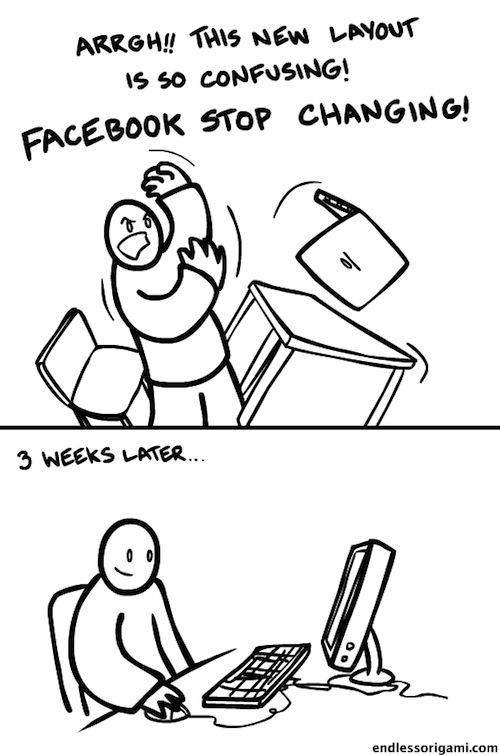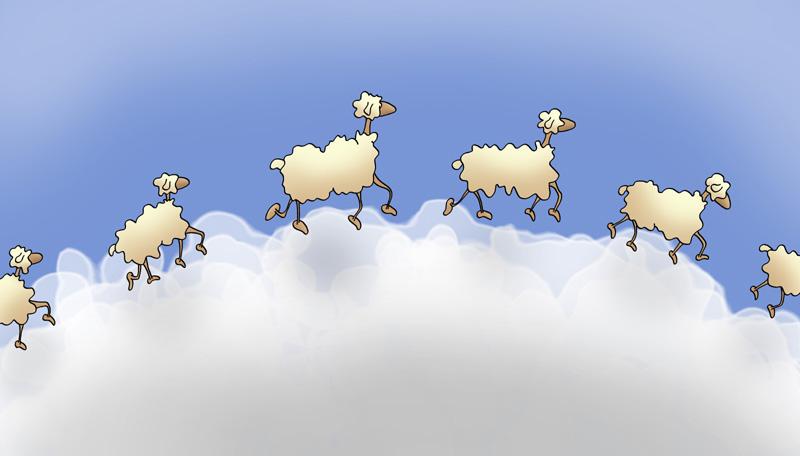I share with you here a little reflection that I made to myself and according to which for innovate and reinvent yourself, maybe sometimes we should try not to be a slave to numbers and statistics, because probing people who are inherently resistant to change can push us into inaction.
The idea is to try to go off the beaten track from time to time, because from both an artistic and entrepreneurial point of view, change and innovation, sometimes subjective or irrational, can sometimes work wonders.
Note: this content originally published in 2012 was republished in 2023, and is the 6th in a series of course on Management 2.0, the summary of which can be found here.
Not evolving means disappearing
New markets, new technologies, new challenges… many reasons push companies to evolve, whether through successive layers or through real revolutions. Not accepting the idea of change, or being afraid of it for reasons of stability, is to be led to decline, sooner or later.
There is more than one obstacle that can push us not to begin a process of change. We must convince employees, decision-makers, customers, shareholders, stakeholders, public authorities, etc. In short, everything is done to discourage us from evolving. But the price to pay, represented by the effort to be made, can have unexpected benefits in terms of growth, profits, or simply well-being and happiness.
Be careful however, you must not simply innovate for the sake of innovation, but meet a defined objective (competitiveness, modernization, growth, conquering a new target, etc.). Innovation must respond to a clear strategy, just as it pushes us to define new strategies!
Excessive reliance on opinions, surveys and statistics
Does taking into account contradictory opinions lead to weak consensus?
In a context where we are increasingly moving towards corporate governance, the decision-making process must take into account the opinions of all stakeholders. In addition, organizations are the scene of power struggles between lobbies, personal interests and union management (refer to coalition analysis of March and Olsen, 1976).
Consequently, the decisions taken often tend towards a consensus which aims to accommodate everyone a little, or at least not to offend groups of people likely to retaliate by one means or another. This is often the case in politics.
We therefore see that the interest of parties or individuals is not necessarily the general interest, and the decision-making process can lead to choices of lower risk, certainly, but also lower ambition.
A world of surveys, stats and ratings
We live in a world influenced by quantitative data, ratings, statistics and performance forecasts. For each decision, we rely on analysts who recommend what to do. We have the reflex to ask “what the figures tell us” to do.

It is a context which sometimes does not encourage innovation and change, and which does not take much into account the human factor.
Furthermore, making decisions based on forecast statistics and market studies does not necessarily foresee irrational patterns in terms of consumption and the states of grace of an organization that nothing can stop.
Every change should be driven by market alignment, or consumer need, not a creative idea from the imagination of an imaginative leader.
Fear of negative reviews
For each product launch, packaging modification or launch of new features, we usually take consumer opinions into account. To do this, we organize tests, surveys and questionnaires. We submit the products to customers or people, we suggest new features to users, and we wait to see the results.
Generally, the “testers” and others questioned do not approve this or that new logo. Sometimes they reject a new website design. They are against changing the packaging of a product.

And for good reason : people are inherently resistant to change, because it requires a significant effort that people are not ready to make, even if the benefits would be greater behind it. This mode of operation, which would be exclusively focused on waiting for the consumer and asking them if a brand should change, would be like asking a firefighter if becoming an arsonist would be a good thing.
Therefore, rather than listening to consumers literally and responding to their expectations, it would sometimes be wise to interpret their responses to better design your overall strategy, but also your change management strategy, and your communication with people. unhappy.
It is not a question of ignoring them, but rather of interpreting their responses and also taking into account creative processes that do not meet the respondents' criteria. In the event that you do not take the path that the surveys would have suggested, this will necessarily sacrifice consumer comfort for some time, but this sacrifice may sometimes be necessary for your brand to achieve the expected objectives.
The vision of the entrepreneur VS the diktat of figures
The entrepreneurial school (Schumpeter, Collins and Moore, Bennis) emphasizes the importance of intuition, experience and insight of the entrepreneur. Her " vision » is an unquantifiable strategic value, and he centralizes a large part of the power in his person.
Steve Jobs is a leading example of this model. This theory goes against decisions that must be approved by all parties or that result from a hubbub of interests. In terms of innovation and change, this strategy certainly presents risks, but has the merit of making in-depth changes, which sometimes make it possible to move towards the desired objective, which is however not guaranteed, obviously. .
I have often been confronted with this problem of lack of innovation, for example when changing the design of websites with an engaged community, or during organizational issues relating to change management.
In 9 out of 10 cases, surveying stakeholders and using market data led to the same conclusions: not changing anything – either because the current system benefits some, or because the masses are used to it – and align yourself with the market because it is the benchmark to follow, and to move away from it is to take reckless risks.
The biggest risk is not taking any
The conclusion of this article joins its introduction, namely that not seeking to evolve, to take risks, to follow one's intuition and think outside the box, can certainly be synonymous with stability, but also with decline in times of innovation. However, we are living in an era marked by incessant technological surges, which must push brands to to renew constantly, under penalty of being fossilized by new, ambitious, adaptable and initiative-taking competitors.
The example of Aimé Jacquet
In 1996, the coach of the French football team Aimé Jacquet decides not to select Eric Cantona for the Euro which took place that same year in England. Against all expectations, he took the gamble of founding what he called the “new team”, favoring change and a shift towards a playing system based on Zinedine Zidane to prepare for the 98 World Cup.
It excludes not only Cantona, then superstar of the English championship, but also David Ginola. The French team will reach the semi-final of the Euro, before experiencing the success that we know during the 98 World Cup. Years of work, coupled with an unquantifiable state of grace (Golden goal by Laurent Blanc against Paraguay, penalties against Italy, Double by Thuram against Croatia…), defied all the analyzes and criticisms addressed before the competition.
The example of Facebook, Instagram & Others
The design changes of very famous websites like Facebook, Instagram or even Starbucks regarding their logo are blatant examples of resistance to change. With each update, we are treated to the usual protests, from disconcerted, confused and angry users, who beg the brand to return to the previous design which they believe was much better.
Then the protest erodes and ends up disappearing... only to reappear at the next update!

The loss of reference points and small habits is one of the reasons why users are always against a design change. This is why, if you are convinced that change constitutes a step allowing you to achieve a defined objective, then sometimes you have to impose it without complaining.
Mitterrand and the death penalty
On March 16, 1981, while a majority of French people were at that time and according to polls in favor of the death penalty, François Mitterrand, candidate for the presidency of the French Republic, spoke out against the death penalty, during the political show “Carte sur table”. On May 10, 1981, Mitterrand was elected President of the Republic.
It doesn't matter whether you are for or against, that is obviously not the subject here. The idea is to show that a leader can affirm the vision that he believes to be the right one, and succeed in his project even if his idea goes against the surveys and statistics!
“I don’t need to read the polls, which say the opposite (…), I say what I think, what I agree with, what I believe.”
thanks to Mad Salt for the illustration image of the article.
Chapter 7: The corporate social network deciphered in 10 points »
